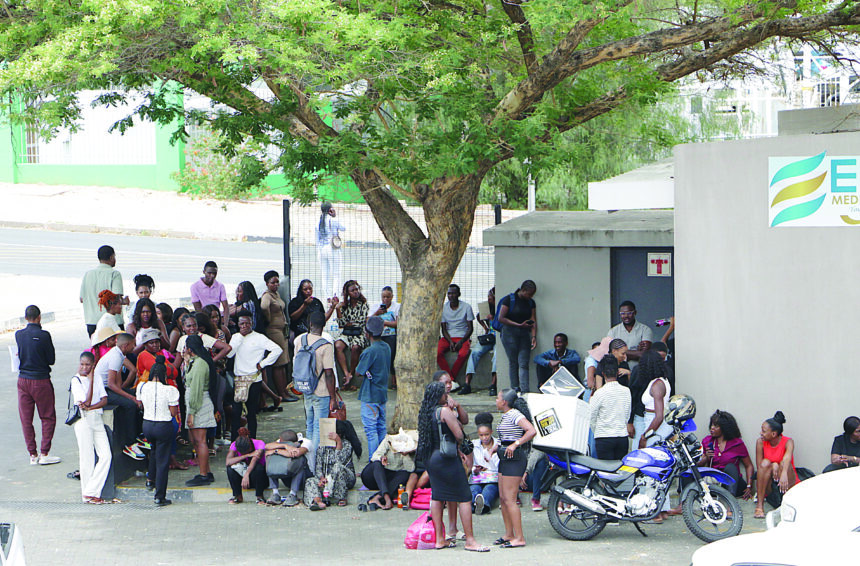Rudolf Gaiseb
The labour ministry has attributed the high levels of youth unemployment in the country to a mismatch between a lack of skills and qualifications among demographic groups to market demands.
“There is a perception that there is a mismatch between what is taught in schools and at institutions of higher learning, and what employers require,” executive director of the ministry Lydia Indombo said.
During a recent New Era interview, she mentioned that amidst limited job opportunities in the labour market, the rapid population growth increases the number of youths entering the job market, outpacing available job opportunities.
With the youth unemployment rate reaching 46%, the ministry said various strides were taken to tackle the issue.
It has an active job-seekers’ system called the Namibia Integrated Employment Information System.
This system collects, stores and updates information concerning names, qualifications and occupations of job-seekers; vacancies in the labour market; and specialised skills and qualifications possessed by Namibian citizens as well as permanent residents and employees in Namibia.
“The ministry managed to place a total of 1 063 job-seekers in employment in various establishments through this system from January 2024 to September 2024. Of these placed job-seekers, 518 are females, while 545 are males.
This ministry has also reduced the threshold of designated employers who are obliged to report vacancies to the ministry, from 25 to 10 employees. This was adopted to promote inclusivity for the informal sector, which forms a large part of the Namibian labour force. The reduction in threshold will likely maximise employment opportunities for job-seekers, as there will be more employers required to report vacancies,” she said.
The labour ministry is offering career guidance, including psychometric testing to pupils, which is a means of providing them with a sense of direction regarding career paths, and making them aware of the opportunities available in the labour market.
In addition, the ministry is in the process of developing the Third National Employment Policy with its implementation plan.
“This policy will help the government to have a position on employment- creation, and ensure the identified strategies and programmes are implemented. The policy is envisaged to be launched in the 2025/26 financial year,” Indombo added.
In the same vein, they are coordinating the implementation of the Employment Impact Assessment, a project in the Harambee Prosperity Plan II.
“The project aims to identify and prioritise investments in projects with high employment-creation opportunities for Namibians by ensuring that government policies, strategic plans, programmes and ministerial budgets include the Employment Impact Assessment. So far, the identified key implementers have received training, and the project will be implemented in the 2025/26 financial year,” she added.
To combat youth unemployment, political parties in their election campaigns provided a myriad of solutions to the unemployment crisis.
The ruling Swapo Party’s
manifesto specifies the allocation of a budget of approximately N$85.7 billion over five years for priority projects which would create mass employment opportunities, leading to the absorption of unemployed graduates and other Namibians looking for jobs.
This notable allocation encompasses creating 256 538 jobs, including tackling youth unemployment.
Similarly, the Panduleni Itula-led Independent Patriots of Change’s manifesto promises to ensure there are jobs in every Namibian family.
“We aim to halve the youth unemployment rate within five years, ensure that 80% of educational institution graduates are gainfully employed within one year of leaving school or university, double youth entrepreneurship within five years, and ensure that 90% of Namibian youths are either in education, employment or training by 2028,” it reads.
The Affirmative Repositioning (AR), headed by Job Amupanda, plans to maintain the National Youth Council (NYC) and the National Youth Service (NYS) as distinct youth development agencies of the government.
They first envisage to take over the administration of youth centres from the directorate of youth development in the ministry, while the national youth service is envisioned to change from a voluntary to a compulsory service.
“A new institution, the Youth Enterprise and Innovation Fund, will be introduced to fund young entrepreneurs, provide market access and support innovation,” the AR manifesto reads.
The Popular Democratic Movement (PDM) plans to reduce unemployment to 11% by 2029.
“To harness the potential of Namibia’s youth, it is imperative to develop policies that stimulate job-creation, support entrepreneurial ventures, and ensure access to quality education and vocational training. By investing in our youth, we can transform this demographic challenge into an opportunity for growth and prosperity, ensuring that Namibia’s future is bright and inclusive for all its citizens,” Venaani said in his party’s manifesto.
Namibians voted in Wednesday’s watershed elections.


